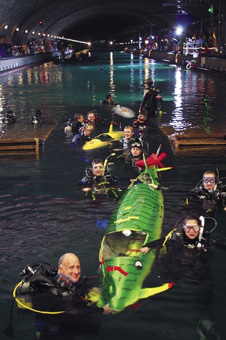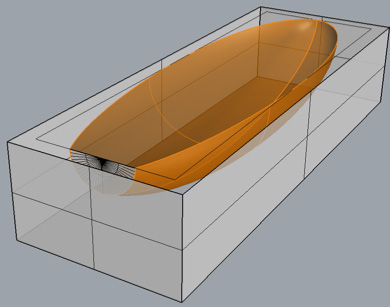Blog 1
We are a highly motivated design team of 4th year Marine Technology students at Newcastle University who are building a human powered submarine to race against other universities and companies at the international submarine races. Our team is composed of a Marine Engineer, two Naval Architects and a Small Craft Technologist.
So our challenge is to build and race a one man Human Powered Submarine. The whole submarine is flooded which means that the pilot uses SCUBA gear, therefore me and my team got do an Ocean Diver qualification with the university for FREE, although you don’t have to dive to be a part of the team if that’s not your thing. There is no maximum amount of people that can join the team and it’s open to all the Marine Technology and potentially Science streams.
Figure 1 Image from the 2013 ISR (International Submarine Races)
The race location alternates each year where on odd years it’s in Washington D.C in America and on even years it’s in Southampton in the UK. At the races we’ll be competing against Bath, Warwick, Southampton, Plymouth and other universities from across the globe. The races at Southampton include a slalom and a straight where the Americans (not surprisingly) have a straight line speed test to see who can hit the highest speed.
There are four different categories that can be entered; one man conventional propulsor (propeller), one man uncongenial propulsor (e.g. using fins to try and propel the submarine like a fish) and then the same differences but with two man submarines.
The world record is held by a Canadian university with 8.035 knots, and at the American races in 2013 only 5/21 teams actually beat 5 knots due to accidentally popping up to the surface or having mechanical malfunctions.
Parts of the submarine that you can get involved in are:
- Propulsion
- Hull form
- Internal powering
- Steering
- Stability
- Planning the Manufacture
- Finance
- Managing
From undertaking such a project you will gain a real insight in to the life of a Naval Architect but you may be looking at the above list and thinking well there’s no way you can contribute because you don’t know where to start or what’s going on, well I’m a fourth year and it took me a while to figure out how to start and there’s plenty of help coming from the lecturers so anyone from any year can help out in some way so don’t panic!
At the moment our designs are pretty much finished, we just need to finish of the propeller so now we are starting our build. During the run up to the build we noticed that designing a working submarine is one thing, but to design a submarine that has to be built is another thing and adds a whole new dimension to designing that you don’t get to experience at university.
Figure 2 CAD Model of the hull form which has been analysed using CFD
(Computational Fluid Dynamics)
Recently I went on a 500 mile road trip which lasted 11 hours to go and collect the submarines mould. The above image shows the hull form that I designed on the computer and the image to the right of it shows the actual block that was made from what I drew on the computer. Seeing it in real life really made it well worth the very long trip, plus driving a long wheel based van was an experience on its own.
And if all that hasn’t put you at the edge of your seat then think about how a project like this would look on your CV and all the great things you’ll be able to talk about in job interviews that nobody else can.
For more information please contact: Max Davidson (Team Captain) m.davidson@ncl.ac.uk
Small Craft Technologist MEng Student


